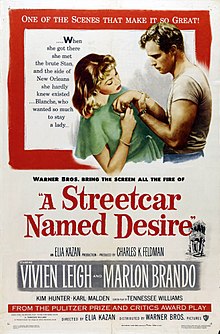A Streetcar Named Desire (1951 film)
| A Streetcar Named Desire | |
|---|---|

Theatrical release poster by Bill Gold
|
|
| Directed by | Elia Kazan |
| Produced by | Charles K. Feldman |
| Screenplay by | Tennessee Williams |
| Based on |
A Streetcar Named Desire by Tennessee Williams |
| Starring | |
| Music by | Alex North |
| Cinematography | Harry Stradling |
| Edited by | David Weisbart |
| Distributed by | Warner Bros. |
|
Release date
|
|
|
Running time
|
122 minutes |
| Country | United States |
| Language | English |
| Budget | $1.8 million |
| Box office | $8 million (North America) |
A Streetcar Named Desire is a 1951 American drama film, adapted from Tennessee Williams's Pulitzer Prize-winning 1947 play of the same name. It tells the story of a southern belle, Blanche Dubois, who, after encountering a series of personal losses, leaves her aristocratic background seeking refuge with her sister and brother-in-law in a dilapidated New Orleans tenement. The Broadway production and cast was converted to film with only minor changes. True to the play, the film is both lyrical and gritty, with complex and contradictory characters. Chief among these was Blanche Dubois, who has become a legendary and iconic figure in film history.
Tennessee Williams collaborated with Oscar Saul and Elia Kazan on the screenplay. Kazan, who directed the Broadway stage production, also directed the black and white film. Marlon Brando, Kim Hunter, and Karl Malden were all cast in their original Broadway roles. Although Jessica Tandy originated the role of Blanche DuBois on Broadway, Vivien Leigh, who had appeared in the London theatre production, was cast in the film adaptation for her star power.
Upon release of the film, Marlon Brando, virtually unknown at the time of the play’s casting, rose to prominence as a major Hollywood movie star. The film marked the first of Marlon Brando's four consecutive Academy Award nominations for Best Actor and earned an estimated $4,250,000 at the US and Canadian box office in 1951, making it the fifth biggest hit of the year. In 1999, A Streetcar Named Desire was selected for preservation in the United States National Film Registry by the Library of Congress as being "culturally, historically, or aesthetically significant".
...
Wikipedia
